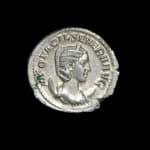Silver Antoninianus of Empress Otacilia Severa, 246 CE - 248 CE
Silver
C.6321
Obverse: M OTACIL SEVERA AVG; Diademed and Draped Bust of the Empress Facing Right on a Crescen Reverse: CONCORDIA AVGG; Concordia Seated to the Left, Holding a Patera and a...
Obverse: M OTACIL SEVERA AVG; Diademed and Draped Bust of the Empress Facing Right on a Crescen
Reverse: CONCORDIA AVGG; Concordia Seated to the Left, Holding a Patera and a Double Cornucopia
Like many personalities of the mid-Third Century, little is known about Marcia Otacilia Severa. She was married to Emperor Philip I, nicknamed the Arab, who ruled from 244-249 A.D. In 237 A.D., she gave birth to a son, Philip II who would become Emperor as well and rule alongside his father. However, after Philip the Arab was killed in battle by forces loyal to Trajan Decius, the Praetorian Guard rose up against the heir to the throne, Philip II, in order to clear the path for Decius’ ascension. It is thought that Severa was murdered alongside her son in late 249 A.D.
How many hands have touched a coin in your pocket or purse? What eras and lands have the coin traversed on its journey into our possession? As we reach into our pockets to pull out some change, we rarely hesitate to think of who might have touched the coin before us, or where the coin will venture to after it leaves our hands. More than money, coins are a symbol of the state that struck them, of a specific time and location, whether contemporary currencies or artifacts of a long forgotten empire. This stunning hand-struck coin reveals an expertise of craftsmanship and intricate sculptural detail that is often lacking in contemporary machine-made currencies. This ancient coin is a memorial to an emperor’s departed wife passed from the hands of civilization to civilization, from generation to generation that still appears as vibrant today as the day it was struck.
Reverse: CONCORDIA AVGG; Concordia Seated to the Left, Holding a Patera and a Double Cornucopia
Like many personalities of the mid-Third Century, little is known about Marcia Otacilia Severa. She was married to Emperor Philip I, nicknamed the Arab, who ruled from 244-249 A.D. In 237 A.D., she gave birth to a son, Philip II who would become Emperor as well and rule alongside his father. However, after Philip the Arab was killed in battle by forces loyal to Trajan Decius, the Praetorian Guard rose up against the heir to the throne, Philip II, in order to clear the path for Decius’ ascension. It is thought that Severa was murdered alongside her son in late 249 A.D.
How many hands have touched a coin in your pocket or purse? What eras and lands have the coin traversed on its journey into our possession? As we reach into our pockets to pull out some change, we rarely hesitate to think of who might have touched the coin before us, or where the coin will venture to after it leaves our hands. More than money, coins are a symbol of the state that struck them, of a specific time and location, whether contemporary currencies or artifacts of a long forgotten empire. This stunning hand-struck coin reveals an expertise of craftsmanship and intricate sculptural detail that is often lacking in contemporary machine-made currencies. This ancient coin is a memorial to an emperor’s departed wife passed from the hands of civilization to civilization, from generation to generation that still appears as vibrant today as the day it was struck.



